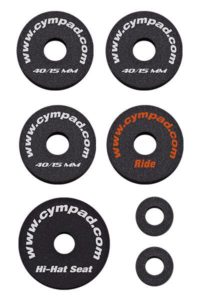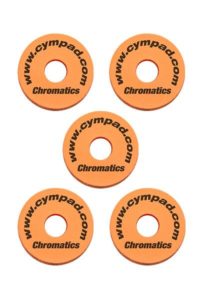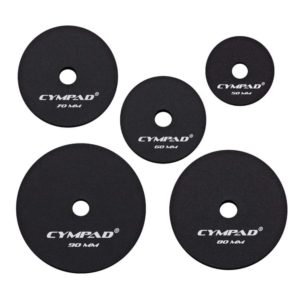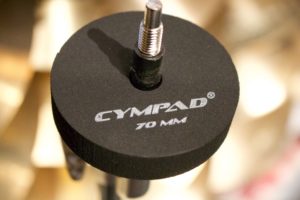By JJ Jones
Cympads are cellular foam cymbal washers meant to be used in place of normal felt washers. I met up with founder Reto Hirschi at the Cympad booth at this year’s NAMM show and he sent me home with a Moderator Super Set (50, 60, 70, 80 and 90mm washers), an Optimizer Starter Pack (three 40mm washers, an extra thick washer for the ride cymbal, and a three-piece set of hi-hat washers), and a set of 40mm Chromatic SE’s (Special Edition), in camouflage.
 OPTIMIZERS
OPTIMIZERS
Cympad’s Optimizer line is flexible and soft with a shock absorbing effect — the principle being that the washer isolates the cymbal from the hardware stand and allows it to “breathe” (sustain longer). Rich Redmond describes his cymbals on Cympads as “floating on a cushion of air” due to the air pockets in the cellular foam.
While the online buyer reviews of the Optimizers on sites like Amazon and Musician’s Friend are generally positive, the typical sentiment is “I think these sound different from felts, but I’m not sure…” It’s true, the difference between the Optimizers and normal cymbal felts is fairly subtle, and if you’re bashing your cymbals in a loud rock club, you’re probably not going to hear it. But if you listen to side-by-side recordings, you can tell the difference; the Optimizers don’t allow for as many harsh overtones as the felts, and the cymbal has a purer tone and more “natural” sound.
 CHROMATICS
CHROMATICS
Made from high-density, cellular “memory” foam, Cympad Chromatics come in a wide selection of colors. This allows you to color coordinate your cymbals with your drum kit. From side-by-side recordings I made, I discovered the Chromatics sounded the same as felts if placed under the cymbal—which makes sense, as the Special Edition washers I was given feel harder and denser than the Optimizers. After trying various combinations of the two types, the best sound I got was from placing an Optimizer underneath the cymbal and a Chromatic on top. (This also makes the cool colors of the Chromatics fully visible!)

MODERATORS
Cympad Moderators are made from softer, less dense foam than that of the Optimizers, and are specifically for use in “reducing cymbal volume and unwanted overtones, controlling sustain and increasing articulation.” In my comparison recordings, the Moderators demonstrated a much more obvious sonic difference from regular cymbal felts than the Optimizers did. Cympad has backed off a bit from claiming that the Moderators actually reduce volume, and now touts these washers as more “tone modifiers,” or as Rich Redmond says, “a sonic alteration tool.”
For this review, I took both video and sound recordings, which proved to be valuable comparison tools, since I could A/B each size next to another, and to a regular felt. Sure enough, as you increase in size, the sound becomes more modified. It’s not so much a decrease in overall volume (although, there is a slight decrease by a few decibels) but rather there is shorter sustain, quicker decay, fewer harsh and high-pitched overtones, and certainly in the larger sizes, when I played the bell of the ride, production of a full-on muted sound as if you’d applied a moon gel to it.

I’m always interested in making cymbals quieter, since I play with a very light touch, and often with acoustic, unamplified musicians. It’s hard to get a “soft” sound on a cymbal with a stick. While I wasn’t a huge fan of the Moderators on the ride cymbal, given they affect the sound of the bell pretty drastically, on the crash, I appreciated the dampening effect and found the 70mm Moderator to be the optimum size. (Anything larger and I started to get strange buzzing overtones after about 20 seconds of sustain. This could be an artifact of the particular size crash I was using—a 17” medium UFIP Class Series. Perhaps the same buzzing would not be present on a cymbal having a different size bell.)
Overall, I like the Cympads and plan to continue using both the Optimizers and Chromatics on my kit. As many reviewers have mentioned, the real place to hear the difference between Cympads and normal felts is in a studio, as nice mics and noise isolation make the improvement that much more obvious. But, now that I’ve done my own side-by-side audio tests and heard the difference, I’m glad to use them. I’m also looking forward to employing the sound control of the Moderators on some acoustic gigs where cymbal volume is so often an issue.
JJ Jones is a Berklee trained, internationally-touring drummer and educator. She has played with folk-pop darlings Girlyman, comedian Margaret Cho, Egyptian revolutionary Ramy Essam, and LA’s riot-pop band WASI, among many others. JJ is the founder of EmpowerDrumming.com, the only drum education company in the world exclusively for women.


